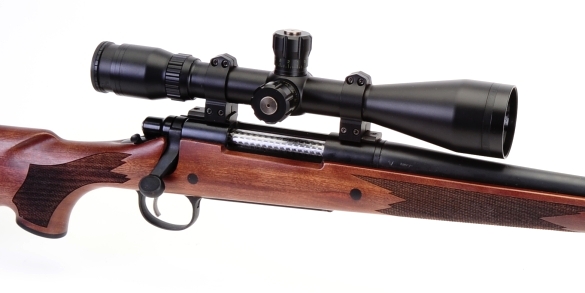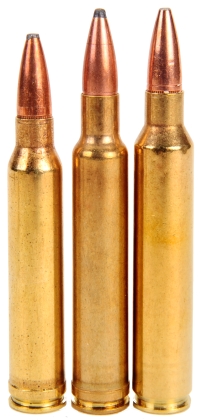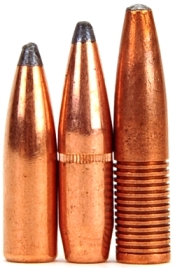
The scope is a Bushnell’s Elite 6500 4.5-30 x 50mm. It is a lot of glass and, no, there aren’t many sporter rifles that can utilize its potential, but this one can. It is a Remington Model 700 CDL, chambered for the 300 Remington Ultra Mag. With an MSRP of $1019 and a typical discount retail price of $850 – $900, it is one of the best values in walnut stocked and blued steel hardware magnums on the market. The more utility SPS matte black and synthetic is priced approximately $200 less at retailers. This combination has been extensively reviewed previously on Real Guns®. What follows is a general summary of the cartridge and some additions to existing Real Guns® handload data.
The attempted beltless coup d’état of 1999
I got to thinking about the Ultra Mag, and the weird events in cartridge development that transpired between 1999 and 2005; the launch of the Ultra Mag, the challenge of the Winchester Short Magnums, Remington’s counter with the Short Ultra Mag cartridges and the culmination of the roller coaster ride with Winchester 223 and 25 Super Short Magnums. During those events, the market place that was once defined by slow accepting, staid and considering consumers gave way to a sea of barking pinnipeds who would clap for any introduction that was labeled “new”, as long as it also condemned anything held up to public ridicule as “old”.
As a marketing tactic, someone figured out a way to demonize a brass extrusion until angry and uneducated villagers were calling for its head, or at least the belted casehead of the H&H cartridge. Beyond the loss of an excellent headspace line of demarcation when cutting chambers for slump shouldered cartridges, firearm enthusiasts were being forced to read each headstamp to positively identify a cartridge as a magnum. Overnight we became… almost European. Ultimately, it appears there is room for belt and beltless cartridges where ballistic superiority applies, and the rest of the smoke and mirrors belted – beltless debate has become moot. No, not snoot… moot.
More specifically the Ultra Mag
 It 1999, Remington began the introduction of a logically constructed family of Ultra Mag cartridges. SAAMI drawing release dates for the family of cartridges are: 1/7/00 300 Ultra Mag, 6/8/99 338 Ultra Mag, 1/10/01 7mm Ultra Mag, and 1/10/01 375 Ultra Mag. The only thing missing is a big 0.458″ Ultra Mag that I am sure would have appealed to only me and six other guys.
It 1999, Remington began the introduction of a logically constructed family of Ultra Mag cartridges. SAAMI drawing release dates for the family of cartridges are: 1/7/00 300 Ultra Mag, 6/8/99 338 Ultra Mag, 1/10/01 7mm Ultra Mag, and 1/10/01 375 Ultra Mag. The only thing missing is a big 0.458″ Ultra Mag that I am sure would have appealed to only me and six other guys.
Ultra Mag family members are earmarked by propellant capacity greater than full length H&H magnums, but not so much greater as to push them into the 416 Rigby / 378 Weatherby Magnum class of cartridges where size dictates special firearm design considerations (i.e. expensive and heavy).
|
Cartridge Type |
Case Diameter |
Belt Diameter |
Rim Diameter |
Overall Length |
Capacity Grains |
| Remington SAUM | 0.551 | N/A | 0.534 | 2.825 | 74 |
| Winchester WSM | 0.555 | N/A | 0.535 | 2.860 | 81 |
| Short Belted H&H | 0.513 | 0.532 | 0.532 | 3.340 | 88 |
| Long Belted H&H | 0.513 | 0.532 | 0.532 | 3.600 | 93 |
| Ultra Mag | 0.551 | N/A | 0.534 | 3.600 | 112 |
| Weatherby Mag* | 0.582 | 0.604 | 0.604 | 3.750 | 122 |
|
Dimensions expressed as inches *378 Weatherby parent case |
|||||
More specifically the Remington 300 Ultra Mag
 Pictured right, 300 Winchester Magnum, 300 Weatherby Magnum and 300 Ultra Mag. If you go beyond just reading the labels on the boxes and listings on manufacturer sites and shoot these rifles over a chronograph with factory ammunition and equal length barrels, the Ultra Mag offers a substantial ballistic bump over the 300 Winchester Magnum and more than a tie breaker increase over the 300 Weatherby Magnum. In 180 grain bullet performance context – 2,960 fps, 3,150 fps and 3,250 fps respectively. Respectively, point blank range is 295 yards, 312 yards and 321 yards. Recoil, following suit is 33 ft-lbs., 39 ft-lbs and 44 ft-lbs. Increases in recoil intensity are exponential, but none of these are severe, except to the big girls who rub their arms in dramatic gesture after shooting a 243 Winchester rifle.
Pictured right, 300 Winchester Magnum, 300 Weatherby Magnum and 300 Ultra Mag. If you go beyond just reading the labels on the boxes and listings on manufacturer sites and shoot these rifles over a chronograph with factory ammunition and equal length barrels, the Ultra Mag offers a substantial ballistic bump over the 300 Winchester Magnum and more than a tie breaker increase over the 300 Weatherby Magnum. In 180 grain bullet performance context – 2,960 fps, 3,150 fps and 3,250 fps respectively. Respectively, point blank range is 295 yards, 312 yards and 321 yards. Recoil, following suit is 33 ft-lbs., 39 ft-lbs and 44 ft-lbs. Increases in recoil intensity are exponential, but none of these are severe, except to the big girls who rub their arms in dramatic gesture after shooting a 243 Winchester rifle.
The 300 Remington Ultra Mag utilizes a conventional long action with an H&H magnum bolt face, as does the 300 Winchester Magnum and 300 Weatherby Magnum. The absence of a belt allows for a magazine capacity of 3 rounds, same as the belted 300 Winchester and 300 Weatherby Magnums. Quality ammo cost for the 300 Winchester Magnum averages $50/20, the 300 Weatherby is priced about the same and the Ultra Mag is $70/20. Reloading any and all makes for big savings for frequent shooters and allows for a wide array of premium bullets and load performance. We’ve conducted a number of projects with the 300 Remington Ultra Mag and published a number of handload data tables, so this time the concentration was on the heavier end of the bullet spectrum.
A good use for all of that powder…

Left, left to right: Sierra Pro-Hunter 180 Grain, Hornady BTSP Interlock 190 grain and North Fork Bonded Core SP 200 grain. The bullets are listed in order of weight, but also in order of ease of expansion. The Pro-Hunter is made to expand quickly and retain weight. It was judged to be a good bullet for soft loading the Ultra Mag for deer season or longer range hunting of larger thin skinned game.
The Hornady 190 grain Interlock has a B.C. just under 0.500 and has a tapered jacket made for tightly controlled expansion and deeper penetration. A good bullet for heavy game at a weight well within the capabilities of the 300 Remington Ultra Mag. Experience suggests that this is a bullet that demonstrates good accuracy and long reach. The 0.580″ shank position of the cannelure doesn’t trade severely on net case capacity.
The North Fork Bonded Core is a bit of a hybrid. The shank is solid copper, however, the nose is bonded lead core. Expansion tests and recovered bullets show deeper penetration than a Nosler Partition and the cored section retains more of its original weight. At 200 grains, the bullet seats to maximum cartridge overall length at 3.600″. It is good for anything big with teeth and other high mass game.
 |
Warning: Bullet selections are specific, and loads are not valid with substitutions of different bullets of the same weight. Variations in bullet material and length will alter net case capacity, pressure and velocity results. Primer selection is specific and primer types are not interchangeable. These data represents maximum loads in our firearms and test equipment and may easily be excessive in other applications. All loads should be reduced by 3%, and developed following safe handloading practices as represented in established reloading manuals produced by component manufacturers. Presentation of these loads does not constitute a solicitation for their use, nor a recommendation.
|
||||||||||||||||||||||||||||||||||||||||||||||||||||||||||||||||||||||||||||||||||||||||||||||||||||||||||||||||||||||||||||||||||||||||||||
|
|||||||||||||||||||||||||||||||||||||||||||||||||||||||||||||||||||||||||||||||||||||||||||||||||||||||||||||||||||||||||||||||||||||||||||||
Please, Joe, stop here… Sorry, I can’t
I’m always puzzled when I hear someone say that the 300 Remington Ultra Mag is a hard kicker. Recoil is a function of equal and opposite force generated by the velocity of bore ejecta. Felt recoil is determined by the weight of the firearm, resilience of shock absorbing material between the firearm and the shooters shoulder and the firearms geometry. Firearms with a lot of drop tend to go muzzle high and hit a shooter’s cheek if there is no cast off. Straight comb guns usually go muzzle climb neutral under recoil and transmit force straight back into the strength of a shooter’s hold. But a big magnum is a big magnum and they all kick. Some folks are particularly sensitive to recoil where the real problem is insufficient ear protection which compounds the sensation of recoil.
My point is, it is kind of silly to complain about recoil in association with a big magnum cartridge and a sporter weight rifle as harsh recoil comes with the territory. For folks use to shooting magnum rifles and have the proper expectation, the Remington Model 700 300 RUM is not difficult to manage and a brake would make it down right easy to shoot.
After extensive shooting experience with the 300 Remington Ultra Mag and the CDL, I can say it is an accurate combination. The group size noted where shot off of a front rest and rear bag without a lot of prep and without really dialing in the handloads. Factory Core-Lokt ammo will do as well, but just a little more expensively. The Remington Model 700 CDL UM remains a great value and a good looker as a high powered sporter.

Email Notification